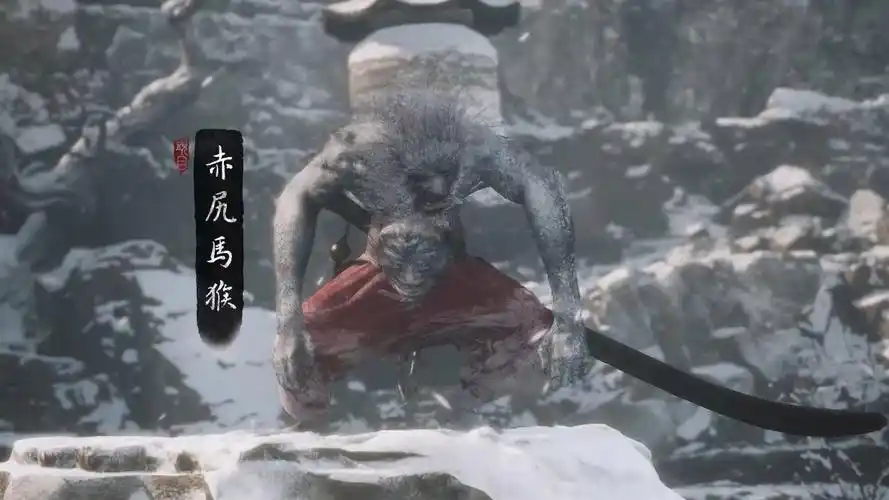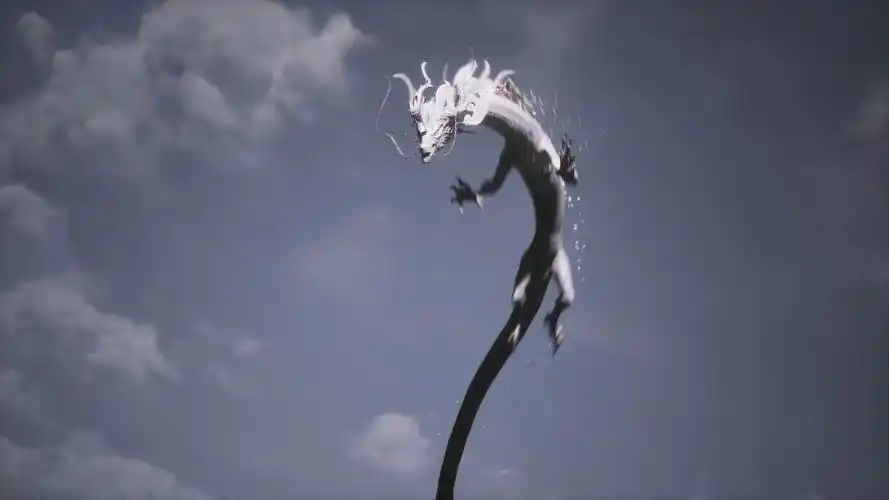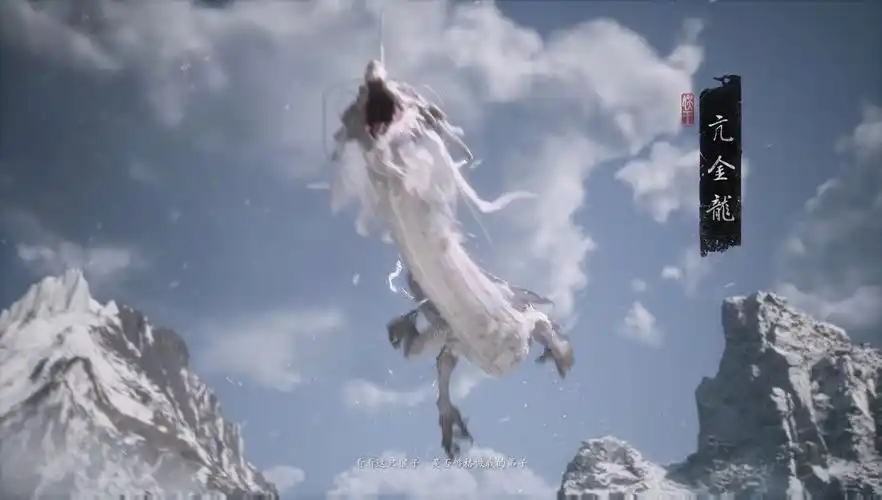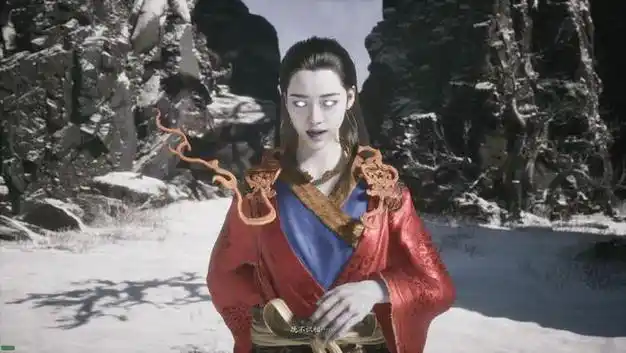In this chapter, the destined one will arrive at Little Western Heaven, where they encounter two characters: Macaque Chief and Kang-Jin Loong.
Macaque Chief is a character from the original “Journey to the West”. In chapter three of “Journey to the West”, it is mentioned that two Macaque Chiefs were appointed by Sun Wukong as “Marshals Ma and Liu”, though they lacked innate supernatural powers. The second mention in the original text is in chapter fifty-eight, where Tathagata Buddha says: “Macaque Chief can understand yin and yang, knows human affairs, is adept at entering and exiting situations, and can avoid death to prolong life.” Since Macaque Chief in “Journey to the West” is entirely a creature of dialogue, his physical appearance is not specifically defined, thus giving Game Science considerable creative leeway in developing this character’s appearance, abilities, and backstory. In the game, as soon as Macaque Chief appears, he uses something resembling a fruit to awaken small creatures on the ground, which may well be a nod to Tathagata Buddha’s description of Macaque Chief’s ability to “avoid death and prolong life.”

Regarding the origin of the Macaque Chief, there are two theories. One claims that he was transformed from the Son of the Loong King of the South Sea after his death and later converted to Buddhism, receiving the title “Attendant of Enlightenment.” Another theory names him as Wuzhiqi from the Huai River, skilled in transformation, able to match the strength of nine loongs, and proficient in controlling water. He was eloquent and well-versed in the depths of the Yangtze and Huai Rivers, as well as the terrain’s elevations and distances. He once led hundreds of thousands of mountain spirits and water demons in a great battle against Yu at the source of the Huai River. Yu initially sent Tong Lu and Wumu You to fight, but both were defeated by Wuzhiqi. Eventually, Gengchen was sent and succeeded in capturing Wuzhiqi. Known for his water control, Wuzhiqi’s abilities differ from those of the Macaque Chief, who understands the Yin and Yang, is adept in human affairs, skilled in entering and exiting situations, and can avoid death to extend life. They are not even of the same subspecies (Wuzhiqi is an ape), hence the claim that Macaque Chief is Wuzhiqi is neither substantiated nor credible.

Kang-Jin Loong, also known as Kang-Jin Star, is a prominent character in “Black Myth: Wukong.” In reality, Kang-Jin Loong and Kang-Jin Star are the same entity; Kang-Jin Loong is the dragon form of Kang-Jin Star.
Kang-Jin Loong was originally one of the Twenty-Eight Constellations, an ancient astronomical concept formed during the Western Zhou period. Ancient astronomers looked up at the night sky near the ecliptic and divided the nearby constellations into several regions. The Twenty-Eight Constellations are a crystallization of ancient Chinese astronomical wisdom. To precisely observe the movements of the sun, moon, and the five planets, the ancients meticulously divided the sky into twenty-eight sectors, associating each constellation with one of twenty-eight animals and appending an element from metal, wood, water, fire, or earth to their names. These constellations are grouped according to the four cardinal directions: seven in the Azure Dragon of the east, seven in the Vermilion Bird of the south, seven in the White Tiger of the west, and seven in the Black Tortoise of the north, each constellation symbolized by an animal. These characters frequently appear in “Journey to the West”; for instance, Kui Wood Wolf once descended to the mortal realm and transformed into the Yellow Robe Fiend, and Mao Day Chicken once helped Sun Wukong subdue the Scorpion Spirit.

Kang-Jin Loong, whose star name is “Kang” and element is “metal,” is named after the “dragon” and belongs to the Azure Dragon of the east. It is the second constellation of the eastern sector, representing the neck of the Azure Dragon and embodying the essence of the dragon.
In the original text of “Journey to the West,” the gender of Kang-Jin Loong is not specified, nor is it defined in the Taoist scriptures. In the novel, Kang-Jin Loong once appeared to help Sun Wukong when he was trapped inside the Golden Cymbals of Yellowbrow. Kang-Jin Loong used the sharp horns on its head to drill into the cymbals and freed Wukong. In this scene, Kang-Jin Loong seems to be characterized as male. According to the Qing dynasty’s colorfully illustrated version of “Journey to the West,” Kang-Jin Loong is depicted wearing a blue robe, with a dragon-like head, long hair, and two sharp horns atop its head. In the 1986 TV series adaptation of “Journey to the West,” the portrayal of Kang-Jin Loong was inspired by the Qing dynasty illustrations, changing the character’s gender to male and altering the dual horns to a single horn, though the character was not particularly handsome.
In the game, the image of Kang-Jin Loong is based on the sculptures of the Twenty-Eight Mansions at the Yu Huang Temple in Jincheng, Shanxi, works by the Yuan dynasty sculptor Liu Luan. These sculptures are well-preserved and vividly depict the characters. Within this collection, the depiction of Kang-Jin Loong as a female is quite rare. She appears fierce with glaring eyes, her long hair standing on end, and a giant dragon coiled beside her, presenting a valiant figure.
There are various reasons why Kang-Jin Loong is set as a female character in the game. Kang-Jin Loong is associated with the metal element, which can be further divided into yin metal and yang metal, allowing for the representation of both female and male aspects. This is seen as a manifestation of the yin and yang attributes of Kang-Jin Loong in different positions and sequences. Consequently, in the Jincheng Jade Emperor Temple, Kang-Jin Loong is presented in a female form. However, in Liang Lingzan’s “Illustrations of the Forms of Gods for the Five Planets and Twenty-Eight Constellations” from the Tang dynasty, Kang-Jin Loong is depicted as a male, wearing a tall crown and sporting a beard.
In the game, Kang-Jin Loong is portrayed as a female character, continuing the tradition of the Jincheng Jade Emperor Temple and also better suited for unfolding subtle and intricate emotional storylines. The term “Kang” signifies the neck, as Kang-Jin Loong is located at the neck position within the Seven Constellations of the Azure Dragon, which are arranged in the shape of a dragon. The constellations—horn, neck, root, room, heart, tail, and whirlwind—correspond to the dragon’s horn, neck, forelegs, chest, heart, tail, and the whirlwind at the tail, respectively. The true form of Kang-Jin Loong is a dragon, which also mimics the shape of the constellations, a tradition that hails from the ancient night sky. Therefore, Game Science’s decision to set Kang-Jin Loong as a female enhances the portrayal of the game’s narrative.
